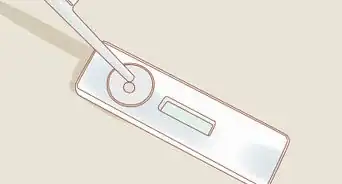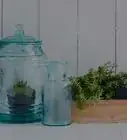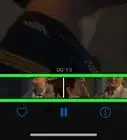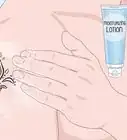This article was co-authored by Kate Jutagir. Kate Jutagir is an Equestrian Specialist, Hunter/Jumper Trainer, and the Owner of Blackhound Equestrian, a premier training barn located on 65 acres in Castro Valley, California. Originally designed to be a riding school used as a springboard for dedicated students into careers in the sport, Blackhound Equestrian has grown into a hunter/jumper training program for all levels focusing on providing a solid foundation needed for personal advancement in the sport. Kate has over 25 years of equestrian instruction and training experience. Her focus on developing horse and rider partnerships provides a complete equestrian education for both beginners and advanced riders alike.
This article has been viewed 36,541 times.
Catching your horse in order to saddle her up for a ride, work her in the field, or groom her can be frustrating. If not done properly the process of catching a horse can take a long time which will leave both you and the horse exhausted and less likely to enjoy the activities that follow. Proper technique when catching a horse can greatly reduce the amount of time and effort so that you can more quickly get to the activities you and your horse love.
Steps
Approaching the Horse
-
1Approach the horse from the front and slightly to one side. She should be able to see you coming. Sneaking up on the horse from behind can startle it and cause it to kick.[1]
- Make sure you have your rope, halter, and maybe a treat with you before you go out to catch your horse.
- Talk to the horse as you approach. Use a quiet calming tone to let her know you are coming and that you don't mean her any harm.
-
2Start walking toward the horse slowly. Take easy deliberate steps. Don’t rush after the horse or it will get scared and run away from you. If the horse seems startled or if it turns away, stop and wait for her to settle down before advancing again.Advertisement
-
3Hold your arms down. Don’t approach with the halter outstretched. This will startle the horse. It may recognize the halter and panic. Also, keeping your arms down will make you appear more neutral and less threatening.
-
4Don’t make any sudden movements. Waving your hands or advancing too quickly toward the horse will cause it to run away.[2]
-
5If the horse runs away, don’t go running after it. If the horse does get spooked and makes a run for it just stay where you are. Chasing after it will only startle it even more. Instead, wait for it to stop. Give the horse a few minutes to feel safe again, then start advancing slowly and try once more.
Relaxing the Horse
-
1
-
2Step back after a couple of strokes. This is called giving the horse “release." After you have spent a few seconds caressing the face or neck, step back in full view of the horse. Stand with a non threatening pose, arms down, feet together, to show the horse that you mean it no harm.
-
3Pet the horse again. After you’ve given the horse some “release” step back toward it and start caressing the face and neck again. This way you are building trust with the horse.
- Swat some flies out of the horse’s face if there are any.
- Try talking to the horse in a calm voice. It may not know what you are saying, but the sound of your voice can show you mean it no harm.
-
4Repeat petting and giving the horse release. Keep this pattern up for about four or five minutes. The horse should start to calm down. [5] Each time you advance to pet it again, spend a little more time with it. You’ll know the horse is calm if it lowers its head to receive your caress or if it continues to eat or remains relatively still while you are touching it.
Catching the Horse
-
1Slide the halter onto the horse. Once the horse is calm, approach it one last time. Pet the face and neck and as you do, slide the halter onto the horse's nose. Bring your other arm up around the neck to secure the clasp around the back of the head. After it is secure, continue to pet the horse and keep it calm.
-
2Don’t strap the halter on tight. The halter should be snug but not so tight it is digging into the horse's face. There should be enough slack under the horse's face so that you can slip two fingers in between the horse and the halter without much resistance. [6]
-
3Avoid tugging hard on the rope. Once the halter is secure, let some of the slack from the rope hang between you and the horse. Tugging too hard or pulling the horse with too much force will anger or startle it.
-
4Lead the horse slowly. Pull lightly on the rope, just enough so that the horse can feel the pressure and understand that you want it to follow you.
Making Your Horse Easy to Catch
-
1Visit your horse in the field often without intending to catch it. When you can, go out into the field with a treat or some grains and visit the horse. Approach it slowly, feed it the treat, and then walk away. The horse will learn that being approached by a human is not always a threatening thing. Then, when you do want to go out and catch your horse, she will be more open to having you approach her Gently bring the halter and rope into view and let them sniff it if need be this will make them more relaxed around it.
-
1Make getting caught easy and enjoyable for the horse. When you do catch the horse and bring it in to do some work or saddle it up for a ride, make sure you are doing everything you can to make it pleasant for the horse.
- Bring her some treats.
- Feed her some grains after she gets caught.[7]
- Give the horse a thorough grooming.
- Vary up the work to keep your horse interested.
- Praise your horse when she does something well.
-
2Take your horse out often. The more often you take your horse out, even just to lead her down a short path or give her a new area to run around in, the more likely she is to be willing to be caught.
-
3Let your horse have fun with you and on her own. It’s important to create a relationship with your horse and to give her time to play on her own and with other horses.
- Take your horse for an easy trail ride.
- Spend some extra time grooming and pampering your horse.
- Give her treats.
- Let her out with other horses she enjoys being with.
Community Q&A
-
QuestionHow long until a horse respects you?
 Kate JutagirKate Jutagir is an Equestrian Specialist, Hunter/Jumper Trainer, and the Owner of Blackhound Equestrian, a premier training barn located on 65 acres in Castro Valley, California. Originally designed to be a riding school used as a springboard for dedicated students into careers in the sport, Blackhound Equestrian has grown into a hunter/jumper training program for all levels focusing on providing a solid foundation needed for personal advancement in the sport. Kate has over 25 years of equestrian instruction and training experience. Her focus on developing horse and rider partnerships provides a complete equestrian education for both beginners and advanced riders alike.
Kate JutagirKate Jutagir is an Equestrian Specialist, Hunter/Jumper Trainer, and the Owner of Blackhound Equestrian, a premier training barn located on 65 acres in Castro Valley, California. Originally designed to be a riding school used as a springboard for dedicated students into careers in the sport, Blackhound Equestrian has grown into a hunter/jumper training program for all levels focusing on providing a solid foundation needed for personal advancement in the sport. Kate has over 25 years of equestrian instruction and training experience. Her focus on developing horse and rider partnerships provides a complete equestrian education for both beginners and advanced riders alike.
Equestrian Specialist & Trainer Just like people, some horses will require a longer time to get engaged and listen to you. Other times, it can happen pretty quickly, but it's all based on repetition and patience.
Just like people, some horses will require a longer time to get engaged and listen to you. Other times, it can happen pretty quickly, but it's all based on repetition and patience. -
QuestionHow do you get better at mounting a horse?
 Kate JutagirKate Jutagir is an Equestrian Specialist, Hunter/Jumper Trainer, and the Owner of Blackhound Equestrian, a premier training barn located on 65 acres in Castro Valley, California. Originally designed to be a riding school used as a springboard for dedicated students into careers in the sport, Blackhound Equestrian has grown into a hunter/jumper training program for all levels focusing on providing a solid foundation needed for personal advancement in the sport. Kate has over 25 years of equestrian instruction and training experience. Her focus on developing horse and rider partnerships provides a complete equestrian education for both beginners and advanced riders alike.
Kate JutagirKate Jutagir is an Equestrian Specialist, Hunter/Jumper Trainer, and the Owner of Blackhound Equestrian, a premier training barn located on 65 acres in Castro Valley, California. Originally designed to be a riding school used as a springboard for dedicated students into careers in the sport, Blackhound Equestrian has grown into a hunter/jumper training program for all levels focusing on providing a solid foundation needed for personal advancement in the sport. Kate has over 25 years of equestrian instruction and training experience. Her focus on developing horse and rider partnerships provides a complete equestrian education for both beginners and advanced riders alike.
Equestrian Specialist & Trainer Read some books and really study horse care and horse behavior. Also, set yourself up for success by working with an experienced horse, so the animal can guide you. The more time you give yourself with the experienced horses, the more skilled you'll become.
Read some books and really study horse care and horse behavior. Also, set yourself up for success by working with an experienced horse, so the animal can guide you. The more time you give yourself with the experienced horses, the more skilled you'll become. -
QuestionHow do you close the gate without your horse running away?
 Community AnswerHave a hold on the halter so that won't happen. Just don't wrap it around your hand or you could hurt your hand.
Community AnswerHave a hold on the halter so that won't happen. Just don't wrap it around your hand or you could hurt your hand.
References
- ↑ Jessica Rude. Equine Expert. Expert Interview. 18 September 2020.
- ↑ Jessica Rude. Equine Expert. Expert Interview. 18 September 2020.
- ↑ Kate Jutagir. Equestrian Specialist & Trainer. Expert Interview. 31 March 2020.
- ↑ http://horseandrider.com/article/hard-to-catch-horse-23593
- ↑ http://horseandrider.com/article/hard-to-catch-horse-23593
- ↑ http://horseandrider.com/article/hard-to-catch-horse-23593
- ↑ Jessica Rude. Equine Expert. Expert Interview. 18 September 2020.
About This Article
To catch a horse, you'll need a rope and halter, as well as treats, which will encourage the horse to be less scared of you. While speaking to the horse in a quiet, calming tone of voice, approach it slowly. If it starts moving away from you, stop and wait for it to settle down before continuing toward it. Also, keep your arms down to appear less threatening and prevent the horse from noticing the halter in your hand, since that might make it panic. Once you're close enough, reach out slowly to pet the horse's head and neck, and give it a minute to get used to you. Then, slide the halter over its nose and clasp it behind its head. For more advice, like how to make your horse easy to catch, read on.
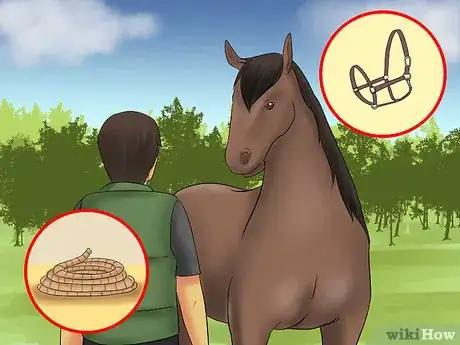

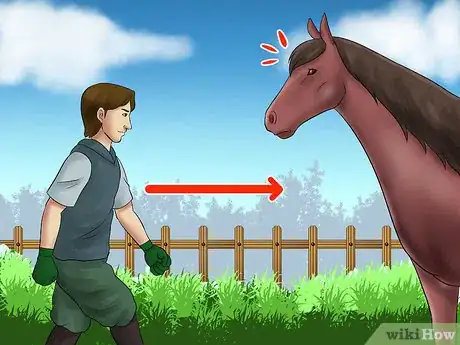
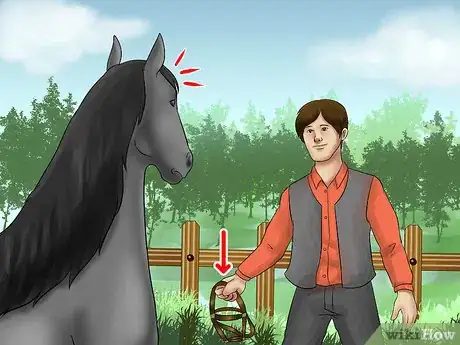
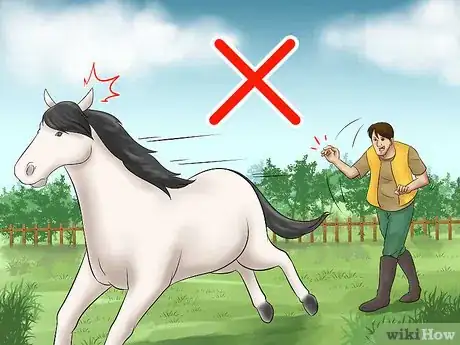
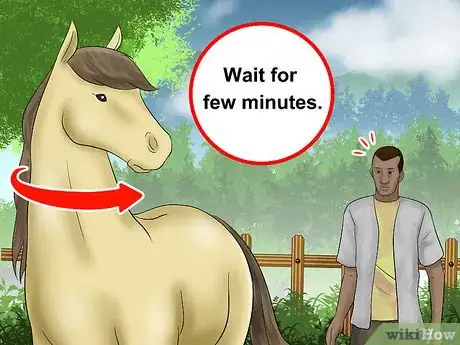





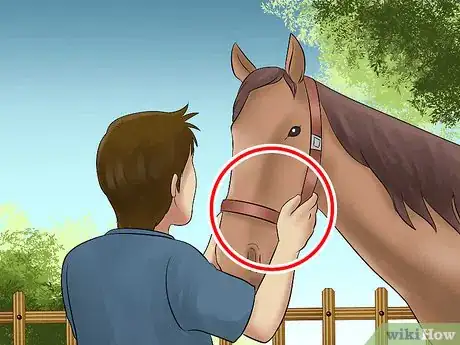

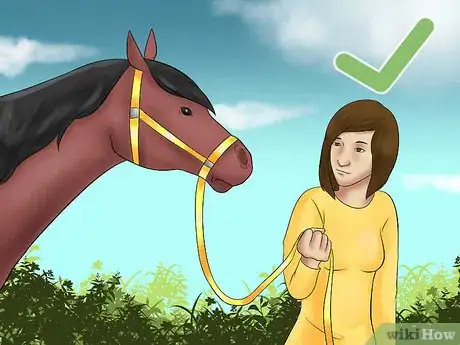








-in-Horses-Step-4-Version-2.webp)

